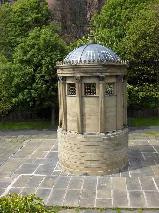Huskisson, William |
| STATESMAN (ENGLAND) |
|
BORN 11 Mar 1770, Birch Moreton Court, Worcestershire - DIED 15 Sep 1830, Eccles, Lancashire CAUSE OF DEATH train accident GRAVE LOCATION Liverpool, Merseyside: St. James' Cemetery |
|
William Huskisson was educated in England and lived with his uncle in Paris before he returned to England in 1792. In 1796 he was elected as a Tory. William Pitt chose him as secretary for the treasury 1804. In 1806 Pitt resigned and Huskisson lost his position. In 1810 he published "Depreciation of the Currency" and this helped him to become a leading economist. From 1827 to 1828 he was colonial secretary and leader of the House of Commons, but he refused to serve under Wellington, who became Prime Minister in 1828. Huskisson now became a reformer with the Convervative Party, speaking in favour of Catholic Emancipation and advocating the bulding of railways. In 1830 he was the first person to be killed by a locomotive. This happened at Parkside Station during the official opening of the railway from Liverpool to Manchester. He stepped from his carriage to speak to Wellington. Together with some others he stood in the middle of the road as another locomotive approached at high speed. The others managed to save themselves, but the locomotive badly crushed Huskisson's leg under the eyes of his wife. He was taken to the vicarage of Eccles but attempts to save his live failed. His statue at Princess Avenue in Liverpool was removed after riots in 1981, because it was thought that he was a slave trader. This was false and the statue is now at the Oratory, St. James' Mount Gardens. Related persons • was painted by Rothwell, Richard • has a connection with Wellington, Arthur Wellesley, 1st Duke of |
| Images |
Sources • Just a moment... |



